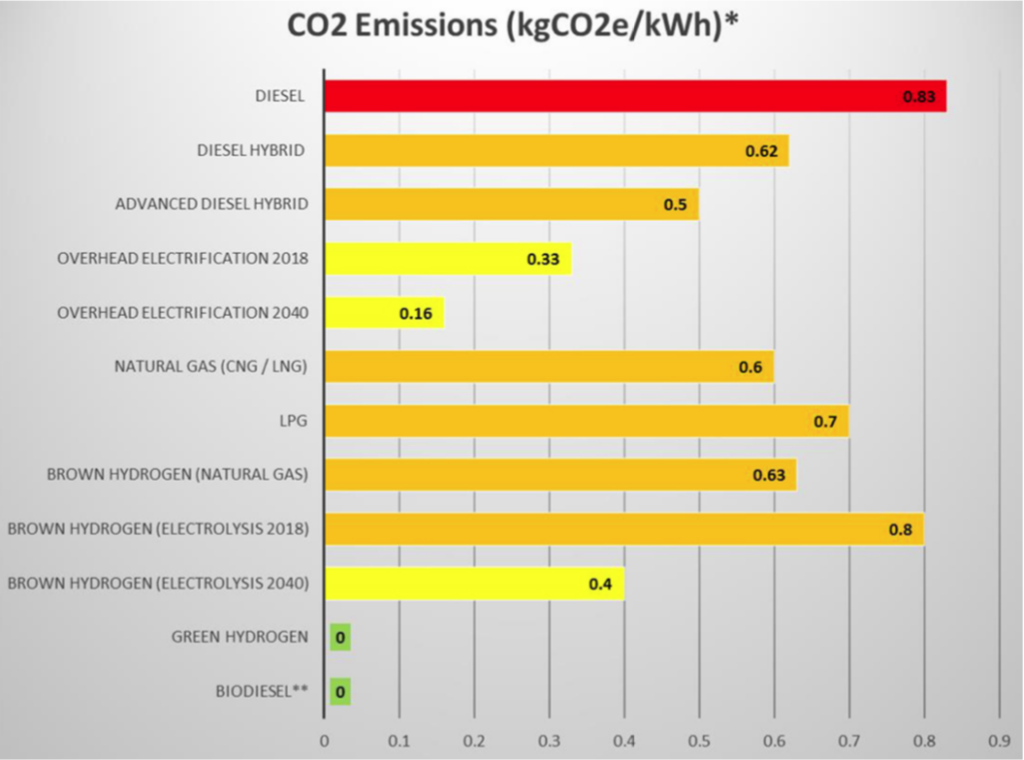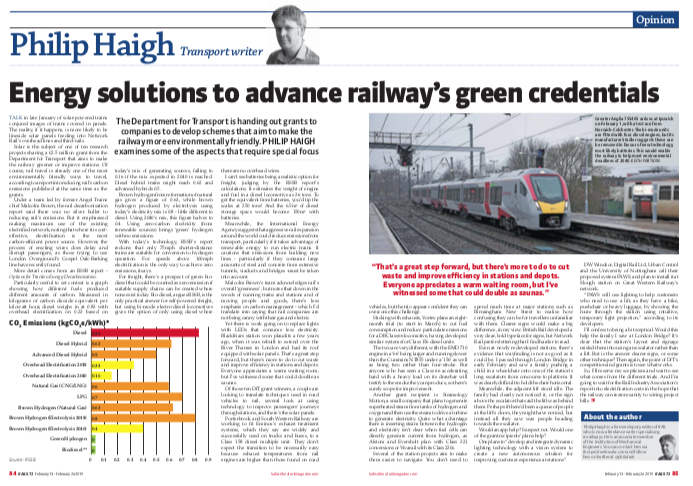Talk in late January 2019 of greener, solar-powered trains conjured images of trains covered in panels. The reality, if it happens, is more likely to be lineside solar panels feeding into Network Rail’s overhead lines and third-rails.
Solar forms one of ten research projects sharing a £3.5 million grant from the Department for Transport that aims to make the railway greener or improve stations. Of course, rail travel is already one of the most environmentally friendly ways to travel, according to a report into reducing rail’s carbon emissions published at the same time as the grants.
Under a team led by former Angel Trains chief Malcolm Brown, the rail decarbonisation report said there was no silver bullet to reducing rail’s emissions. It emphasised making maximum use of the existing electrified network. It noted that where it is cost-effective, electrification is the most carbon-efficient power source. However, the process of erecting wires does delay and disrupt passengers as those trying to use London Overground’s Gospel Oak-Barking line have recently found.
More detail comes from an RSSB report Options for Traction Energy Decarbonisation. Particularly useful is a graph showing how different fuels produced different amounts of carbon. Measured in kilograms of carbon dioxide equivalent per kilowatt hour, diesel weighs in at 0.83. Overhead electrification sits on 0.33 based on today’s mix of generating sources. It falls to 0.16 if the mix expected in 2040 is reached. Diesel hybrid trains might reach 0.62 and advanced hybrids 0.5.
Brown hydrogen from reformation of natural gas gives a figure of 0.63. Brown hydrogen produced by electrolysis using today’s electricity mix is 0.8, little different to diesel. Using 2040’s mix, this figure halves to 0.4. Using zero-carbon electricity (from renewable sources) brings ‘green’ hydrogen with no emissions.
Switching fuels
With today’s technology, RSSB’s report reckons that only 75mph shorter-distance trains are suitable for hydrogen. For speeds above 100mph, it says that electrification is the only way to achieve zero emissions.

For freight, there’s a prospect of green bio-diesel counting as zero-emission. It needs suitable supply chains where none exist today. Bio-diesel is, says RSSB, the only practical answer for self-powered freight. However, bi-mode locomotives give the option of using electricity where there are overhead wires.
Batteries are not a realistic option for freight judging by the RSSB report’s calculations. It estimates the weight of engine and fuel in a diesel locomotive as 36 tons. To get the equivalent from batteries, you’d tip the scales at 250 tons!
Steps to a greener railway
Meanwhile, the International Energy Agency suggests that aggressive rail expansion around the world could reduce emissions from transport, particularly if it takes advantage of renewable energy to run greener electric trains. It cautions that emissions from building new lines – particularly if they use large amounts of steel and concrete from extensive tunnels, viaducts and bridges – must be taken into account.
Malcolm Brown’s team acknowledges rail’s overall ‘greenness’ but notes that down in the weeds of running trains and stations and moving people and goods, there’s less emphasis on carbon management. I reckon he means that rail companies are not being canny with their gas and electricity.
Yet there is work going on to replace lights with greener LEDs that consume less electricity. Blackfriars station won plaudits a few years ago when it was rebuilt to extend over the River Thames in London and had its roof equipped with solar panels. That’s great but there’s more to do to cut waste and improve efficiency in stations and depots. Everyone appreciates a warm waiting room but I’ve witnessed some that resemble saunas.
Of those ten DfT grant winners, a couple are looking to translate techniques used in road vehicles to rail, several look at using technology to improve passengers’ journeys through stations and there’s the solar panels.
Bringing greener exhausts
Porterbrook and South Western Railway are working to fit Eminox’s exhaust treatment systems to a Class 158 diesel multiple unit. They say the systems are widely and successfully used on trucks and buses. They don’t expect the transition to be easy because rail engine exhaust temperatures are higher than those found on road vehicles but the trio appear confident they can overcome this challenge.
Sticking with greener exhausts, Vortex plans an eight-month trial from March to cut fuel consumption and reduce particulate emissions for a DB Class 66 locomotive. It has developed similar systems for Class 156 diesel units. The two are very different. The EMD 710 engine in a ‘66’ is larger and slower than the Cummins NT855 under a ‘156’. But anyone who has seen a Class 66 accelerating hard with a heavy load will testify to the smoke they can produce. So there’s scope to improve.
Another grant recipient is Steamology Motion which is a small company that plans to generate superheated steam from tanks of hydrogen and oxygen and then use the steam to drive a turbine to generate electricity. Quite what advantage there is inserting steam between the hydrogen and electricity isn’t clear when fuel cells can directly generate current from hydrogen.
Making stations easier to use
Several of the station projects aim to make them easier to navigate. You don’t need to spend much time at major stations such as Birmingham New Street to realise how confusing they can be for travellers unfamiliar with them. Clearer signs would make a big difference, in my view. British Rail used a very clear typeface for signs but Network Rail prefers lettering that I find harder to read.
Even at newly redeveloped stations, there’s evidence of poor wayfinding. At London Bridge in early February. I saw a family pushing a child in a wheelchair onto a long escalator from concourse to platform. It was clearly difficult to hold the chair horizontal. Meanwhile the adjacent lift stood idle. The family had clearly not noticed it. Perhaps if there’d been a queue at the lift’s doors, they might have noticed? Instead all they saw was people heading towards the escalator.
Would an app help? I suspect not. Would one of the grant recipients’ plans help? DW Windsor, Digital Rail Ltd, Urban Control and the University of Nottingham call their proposed system PAWS and plan to install it at Slough station on Great Western Railway’s network. “PAWS will use lighting to help customers who need to use a lift, by showing the route through the station using intuitive, temporary light projection,” they said.
I’m a bit sceptical. Would this help the family I saw at London Bridge? It’s clear that the station misled them into using an escalator rather than a lift. But is the answer clearer signs or some other technique? Then again, the point of DfT’s competition and grants is to see what works.
So I’ll reserve my scepticism and wait to see what comes from the different trials. And I’ll wait for the Rail Industry Association’s report into electrification costs and hope that the railway can restore sanity to wiring project bills.
This articles first appeared in RAIL 872, published on February 13 2019.
